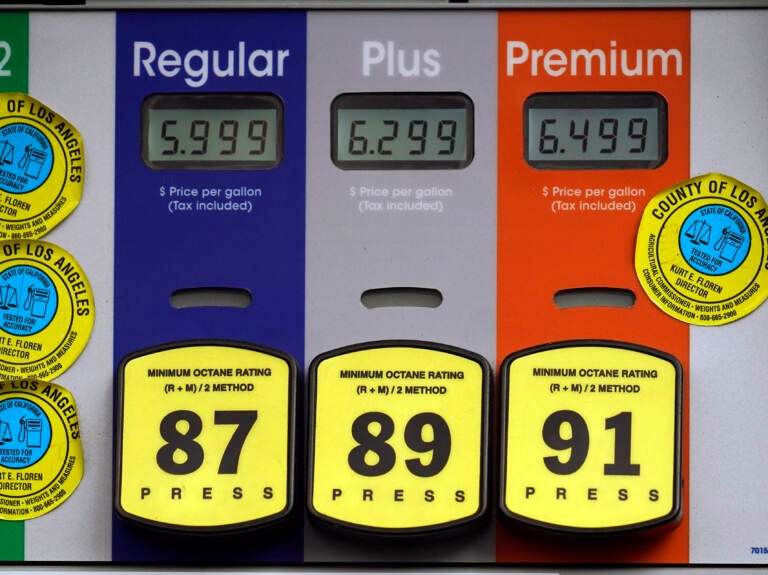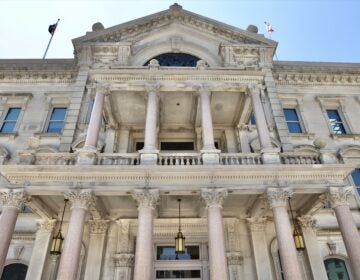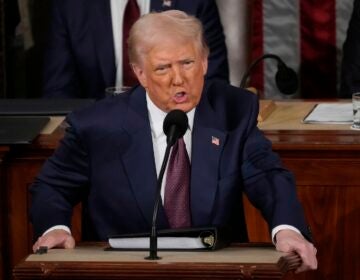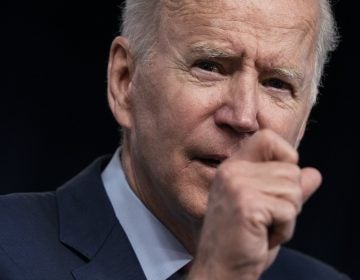Gasoline prices are surging. Can Biden actually do something about it?

High gas prices are posted at a full service gas station in Beverly Hills, Calif., Sunday, Nov. 7, 2021. The average U.S. price of regular-grade gasoline jumped by 5 cents over the past two weeks, to $3.49 per gallon. The price at the pump is $1.30 higher than a year ago. Industry analyst Trilby Lundberg of the Lundberg Survey said Sunday the rise comes as the cost of crude oil and ethanol surges. Nationwide, the highest average price for regular-grade gas is in the San Francisco Bay Area, at $4.77 per gallon. The lowest average is in Houston, at $2.98 per gallon. (AP Photo/Damian Dovarganes)
You probably don’t need a news report to tell you that gasoline prices have been surging. Prices are at a seven-year high, up more than a dollar from a year ago.
Rising energy costs, including gasoline as well as natural gas and coal, are a major driver of high inflation. That’s putting pressure on household budgets and creating a major political problem for the Biden administration.
The president recently said that addressing inflation “is a top priority for me,” and his administration has repeatedly alluded to the possibility of some sort of action to push gasoline prices down.
So what can the president actually do? As it turns out, not much.
“It’s a huge toolbox, but most of the tools aren’t that useful,” says Kevin Book, the managing director of Clearview Energy Partners. “That’s sort of the problem most presidents have.”
Here’s a look at some of the options the Biden has at his disposal, and why there are so many drawbacks.
A look at some of the available tools
Increasing the global supply of crude oil would lower prices. But U.S. presidents don’t have a direct way to do this. American oil companies answer to shareholders and owners, not to the government.
Unlike most members of OPEC, the powerful cartel that has direct influence over oil production, “we don’t have a national oil company with spare capacity to bring to market,” Book notes.
So whereas, say, the king of Saudi Arabia can just decide to pump more or less oil, the president doesn’t have that option.
He can, of course, ask the members of OPEC to bring more oil to market — and the Biden administration has done that. The answer was no.
Another option is to release oil from the Strategic Petroleum Reserve (SPR) — the stockpile of crude that the U.S. government stores underground, so the country can cope with any unexpected disruption in crude supply. Sometimes the oil is also sold off to raise money.
It’s not really meant to be a tool to manage prices, but hypothetically, releasing a lot of oil from the reserve would increase supply and push prices down — at least for a while.
But the amount of oil in the reserve is finite, and Louise Dickson, senior oil markets analyst at Rystad Energy, says a one-time release “is not a lasting solution for an imbalance between supply and demand.”
And because the SPR stores crude oil, not gasoline, it wouldn’t immediately push down prices at the pump.
Coordinating releases with other countries that have strategic reserves could help increase the impact — but that puts Biden back in the position of relying on diplomatic persuasion.
Some proposals could backfire
More drastic alternatives have drawbacks. The U.S. could ban crude oil exports, which now make up a huge part of the U.S. oil industry.
But Book from Clearview says banning exports could backfire. It would push U.S. oil prices lower, but that would encourage domestic oil production to go down — which in turn would reduce the global supply of crude and push prices overall even higher.
And the U.S. also imports some types of oil. Those shipments would continue, and those importers would feel the pinch of rising international prices, potentially wiping out any relief to gasoline prices.
Then there’s the idea of reviving “NOPEC” legislation, which would make it possible for the U.S. to sue the members of OPEC for collusion. The idea has been floating around Capitol Hill for years, and always gets fresh attention when oil prices surge.
Going after OPEC could push prices down, but it could also make prices much more volatile, as well as open up a diplomatic can of worms, with the risk of countries retaliating.
This is also not something Biden could do unilaterally — it would require Congressional action.
“I still think we are a ways away from the realistic prospect of NOPEC passage, in part because Republican lawmakers seem content to blame the current energy crisis on Biden’s domestic energy policies and perceived hostility to domestic energy production,” says Helima Croft of RBC Capital.
Another option, which Bloomberg reports the White House is considering, would be to ease some requirements that refineries use a certain amount of biofuel, like ethanol, in their gasoline blends.
Refineries have long complained that the rule imposes undue costs and makes gasoline more expensive, but it has the strong support of the powerful farm lobby in Congress.
Symbolic action is the most likely outcome
Book suspects the most likely course of action is a release from the Strategic Petroleum Reserve.
Congress has already ordered some oil be released from the reserve over the coming years. Biden could shift around the timing of when that oil is released, to push more out now, rather than making a dramatic emergency release.
The pressure to do something to address the problem is just too great, he says, and taking action would show that the administration takes this seriously.
“I feel your pain can be an important political message,” Clearview’s Book says. “It’s not going to do very much for the pocketbook, though.”
What may help on that front is simply time. The Energy Information Agency, in its monthly report on oil markets, predicted that oil prices will start to fall next year. OPEC also predicts a surplus of oil in 2022.
Nobody in the oil industry misses the irony of this moment: Major world leaders are calling for oil use to drop dramatically in the years ahead, to reduce the catastrophic impacts of human-caused climate change.
But in the near term, Biden and other leaders are desperate for energy prices, and eagerly welcome the prospect of increasing oil production.
9(MDAzMzI1ODY3MDEyMzkzOTE3NjIxNDg3MQ001))




